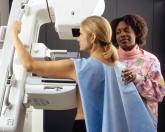News

Screening Mammograms Overdiagnosed More Than 1 Million Women
Major Finding: Compared with the premammography era, routine screening now picks up 122 additional cases of early cancer per 100,000 women – just...

The New England Journal of Medicine study contends that more than 1 million women were overdiagnosed with breast cancer – and overtreated – as a result of screening mammography. How does this affect your thinking on screening mammography – and will it affect practice?
Not Convinced That Change is Called For
Charles B. Hammond, M.D.,
Professor and Chairman Emeritus in the Department of Obstetrics and Gynecology
Duke University
Durham, N.C.
Editorial Advisory Board, Ob.Gyn. News
The NEJM findings do not convince me to change my approach to breast cancer screening. If a woman has no family history or findings on physical examination, I recommend a baseline mammogram at age 35 years, with no more until age 40 years, and then a mammogram every year thereafter. If a woman has a significant family history, I try to get markers on that individual, then repeat mammograms from 35 years on. If the markers are positive, I use other studies with more sensitivity, such as computed tomography, etc.
You can see I am aggressive about this subject. Even with the false positives and surgery involved, this is what I recommend to my patients. I realize this is costly in dollars and in terms of increased concerns for the patients, and that there are low but real risks of surgical complications. I also still advise self breast exams and physician exams yearly, or whenever patients have concerns from their breast self exams. I know mammograms are not perfect and there are false positives and false negatives, but that is what I do and will do until other, better tests are developed.
Follow the Guidelines in Place
Sandra M. Swain, M.D.
President, American Society of Clinical Oncology
Medical Director, Washington Cancer Institute, Washington Hospital Center
Professor of Medicine
Georgetown University
Washington
Women should continue to follow the guidelines that are in place which recommend regular screening. Extensive evidence shows regular screening is important for some women, but more research into the biology of the tumors will be critical to establish which women will benefit most.
Consider the Good and the Bad – and Keep Questioning the Status Quo
Charles Loprinzi, M.D.
Regis Professor of Breast Cancer Research
Division of Medical Oncology
Mayo Clinic
Rochester, Minn.
Associate editor, The Oncology Report
Screening for any cancer (including mammography for breast cancer) can result in good and bad. The good is fairly well appreciated – that is, that a cancer is detected at an early stage, allowing the patient to be treated and cured, when the natural history of the cancer would have been to cause morbidity and/or kill the patient.
However, several bad things can occur with screening, including:
• A false positive result. This can lead to increased concern, testing, and treatment (e.g., bilateral prophylactic mastectomies) for nondisease.
• A false negative result. This may be detrimental in that a patient with a recent normal screening test may ignore a subsequent lump or symptom (that may actually represent a cancer), as she was falsely reassured by the negative test result.
• Finding a cancer that would never have caused morbidity or mortality.
• Finding a cancer that would cause morbidity or mortality but still does (on the same timelines) despite early treatment, thus subjecting the patient to earlier treatment morbidities.
• Diagnosing a cancer and initiating treatment that leads to subsequent major morbidity or mortality, earlier than the cancer would have naturally caused (e.g., a treatment-related leukemia).
• A diagnosis of cancer that leads to treatment (e.g., surgery, radiation therapy, and chemotherapy), with a later determination (by expert pathology review) that the cancer diagnosis was wrong.
For all of these reasons, we need to continue to study and question what we are doing with cancer screening, despite the social and political backlashes that sometimes occur with reports that question the status quo.
The "Ostrich Approach" Makes Little Sense
Howard A. Burris III, M.D.
Chief Medical Officer
Executive Director, Drug Development Program
Sarah Cannon Research Institute
Nashville, Tenn.
Editor-in-chief, The Oncology Report
I agree with Dr. Loprinzi’s thoughtful and well-articulated arguments. Following are a few other thoughts to add to the argument for more study of the issue.
The downstream effects of a screening radiographic finding are the true cost and morbidity issue. In almost all cases, a minor surgery (in this case, a simple lumpectomy) for a mass is preferable to the consumer. The next steps of a lymph node dissection, radiation, hormonal therapy, and chemotherapy are where costs and complications arise. We need to better understand, likely through genomic testing and molecular profiling, which tumors can be treated with minimal surgery and then routine observation. The "ostrich" approach of simply not looking seems to make little sense. Waiting until all breast cancers are palpable is a slippery slope to contemplate, and most certainly will lead to poorer outcomes.
Let the Individual Decide
Maurie Markman, M.D.
Senior Vice President of Clinical Affairs and
National Director of Medical Oncology
Cancer Treatment Centers of America (CTCA)
Philadelphia
Associate editor, The Oncology Report
I agree with the thoughtful comments of Dr. Loprinzi and Dr. Burris.
One additional comment relates to who should be making the decisions regarding whether screening is appropriate for a particular individual. And I would argue strongly that it is the individual, and not some government agency. Clearly, it is essential that such decisions be informed by any available current and future research/data, but the relative importance of the benefits and risks associated with this approach to cancer management can only be assigned by the individual.

Major Finding: Compared with the premammography era, routine screening now picks up 122 additional cases of early cancer per 100,000 women – just...
